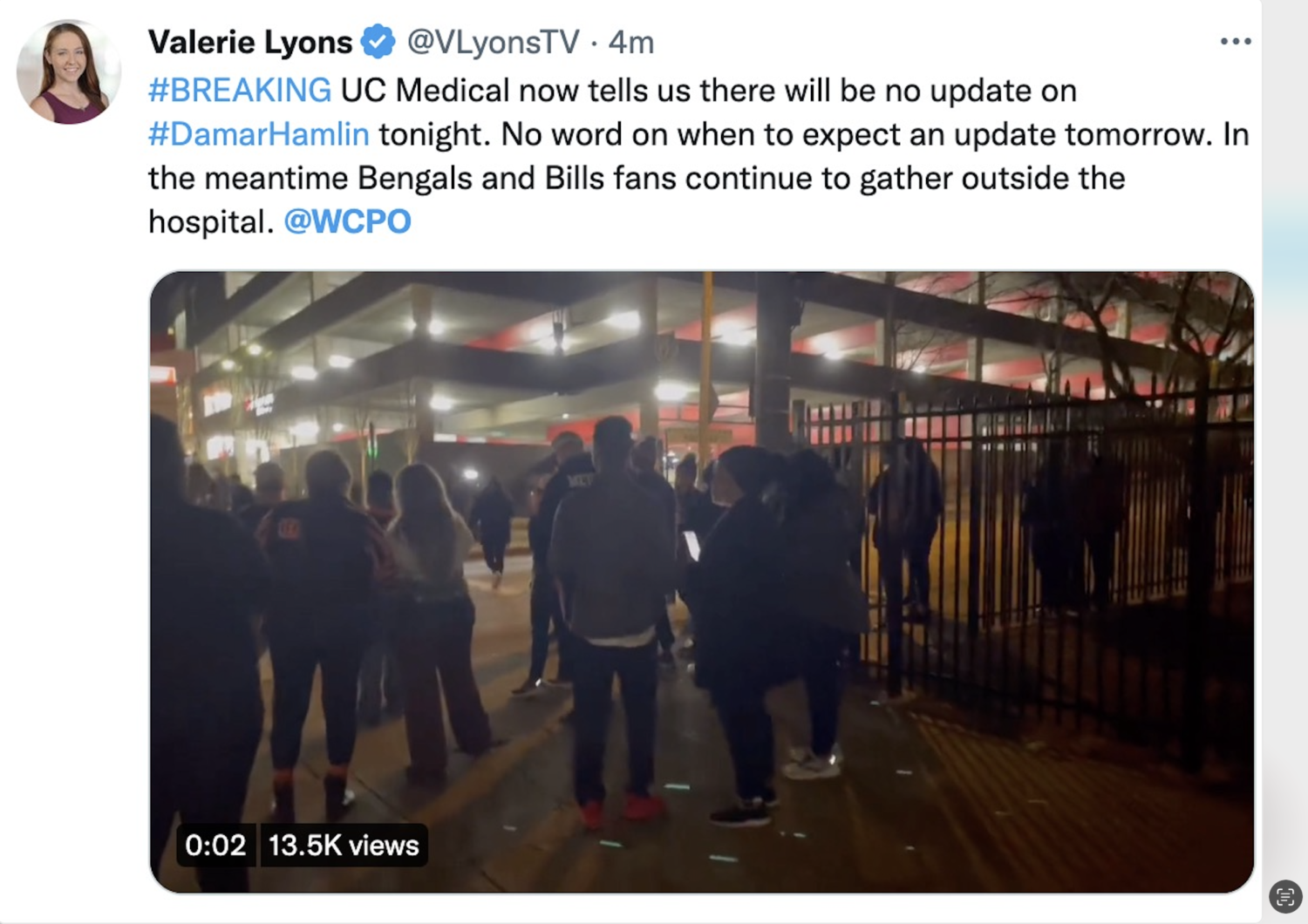More coverage: Al Tompkins offers advice for journalists covering the possible causes and diagnoses of Damar Hamlin’s injury, NFL protocols, and fan reaction.
The scene was as horrific as it was unprecedented. In the first quarter of Monday night’s NFL game between the Buffalo Bills and Cincinnati Bengals, Bills safety Damar Hamlin collapsed after making a tackle.
Seeing a player laying on the field, unfortunately, is not unfamiliar to football. But this time was different. This time you could immediately tell it was more serious. You could tell by how quickly medical personnel scrambled to attend to Hamlin. You could tell by watching the shocked and scared faces of the players on the field.
Then came the grim and almost unbelievable news that Hamlin was given CPR for nearly nine minutes on the field before he was transferred by ambulance to the hospital. Reports late Monday night were that Hamlin was in critical condition at a Cincinnati hospital.

(Twitter)

(Twitter)
WCPO-TV in Cincinnati tweeted that, according to Hamlin’s representatives, his vitals were “back to normal” and that doctors were taking steps to “run a breathing tube down his throat.”
The game was, at first, temporarily suspended with reports that it might continue Monday night. A little more than an hour later, the game was postponed for the night.
ESPN’s coverage of the events was responsible and yet awkward, mostly because information initially was just so scarce and the situation was so critical. Game announcers Joe Buck and Troy Aikman, along with sideline reporter Lisa Salters, stuck strictly to the facts of what they were seeing and hearing at the stadium.
Back in the New York studio, host Suzy Kolber, football analyst Booger McFarland and NFL insider Adam Schefter could only try to describe the emotions of seeing a player collapse on the field and, reportedly, begin fighting for his life.
But without any concrete information, there was not much the broadcasters could say.
Everyone on ESPN spoke in hushed tones, calling for the game to be canceled. Kolber was especially vocal about the game needing to be postponed for the night. Otherwise, the ESPN broadcasters could only repeat things such as, “There are no words” and “There is really nothing we can say at this moment.” All along, all offered prayers.
ESPN, overall, showed restraint by not constantly running the video of Hamlin colliding with Bengals wide receiver Tee Higgins. Hamlin briefly got to his feet, adjusted his facemask then staggered backwards. He seemingly lay motionless while, reportedly, emergency workers cut away his uniform to begin CPR. Partly because players surrounded Hamlin, and partly because ESPN did not zoom in on what was happening, viewers did not see medical personnel working on Hamlin. Over the next 10 minutes or so, ESPN gave viewers updates but also (wisely) kept going to commercials.
In between the long commercial breaks, there were frightening scenes of Bills players sobbing uncontrollably and hugging one another.
After the game was canceled — around 10:01 p.m. Eastern, or about 1 hour and 6 minutes after Hamlin collapsed — ESPN then turned over its coverage to “SportsCenter” anchor Scott Van Pelt. It was then that Salters, emotional at times, gave an outstanding account of what happened immediately after the incident.
Then Salters described the scene outside the locker rooms as the game. Salters reporting from the stadium was superb, as was Van Pelt’s interview with ESPN analyst and former NFL player Ryan Clark. Normally, on Monday nights, Clark is there to dissect the game. But on this particular Monday night, Clark gave a respectful, informative, insightful and, at times, passionate perspective of what the players and coaches were going through watching one of their own in serious condition.
Clark, like everyone else, agreed the game needed to be shut down. And he isn’t sure when football should be played again.
“To watch a man truly go lifeless … .” Clark told Van Pelt. “We’ve seen people knocked out, we’ve seen bad hits. This was even different. The NFL is a big business. And the NFL has to continue doing business. And the NFL has to continue entertaining. But if the NFL doesn’t send somebody into these locker rooms, if the NFL isn’t flying people into Cincinnati right now or to Buffalo or wherever they’re going right now, they are missing the point. The point is make sure these men are all right and then you can play football. … What’s important is Damar Hamlin.”
Van Pelt handled the postgame coverage well.
All in all, ESPN went from covering a game to covering the news. It went from a sports story to a news story, and ESPN’s coverage was important and valuable.
Also of note, the cable news channels — CNN, MSNBC and Fox News — all covered the story extensively, bringing in those versed in sports to comment. CNN had USA Today sports columnist Christine Brennan and broadcaster Bob Costas, Fox News had veteran broadcaster Jim Gray and MSNBC interviewed longtime sports columnists William Rhoden (New York Times, Andscape) and Kevin Blackistone (Washington Post). MSNBC also interviewed medical analyst Dr. Vin Gupta. Other networks also brought on medical experts, including CNN with Dr. Sanjay Gupta.
In Buffalo, the local newspaper, The Buffalo News, had a breaking news headline: “Bills safety Damar Hamlin in critical condition after collapsing on field; game suspended.”
Local Buffalo TV stations also led with the story. On its website, Fox29 had the headline of “Bills safety Damar Hamlin collapses on field after suffering injury against Bengals.” It included a haunting photo of Bills star quarterback Josh Allen with his face in his hands.
The New York Times sent out a breaking news alert to subscribers, and The Washington Post’s website displayed the breaking news prominently.
This story has been updated to include TV networks interviewing medical experts during their coverage.








